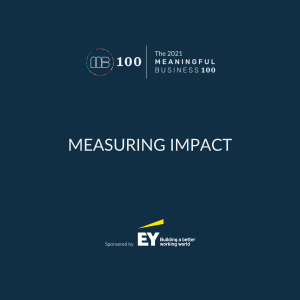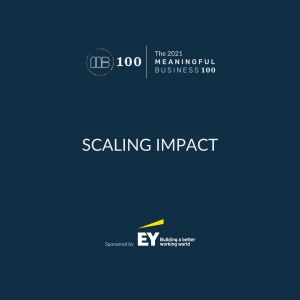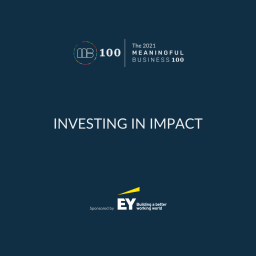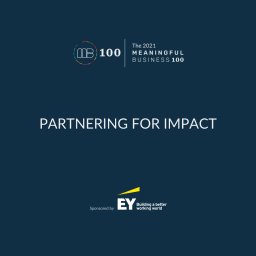Meaningful Business (MB:) How important is it to measure the impact of purpose on your company culture and employee behaviour?
John Rosling (JR:) It’s increasingly important to measure purpose and culture. Purpose is like the organisation’s GPS. Without data it’s hard to know where you’re going, or even where you’ve started from. Robust and credible numbers do something else too; they give the organisation confidence that their purpose initiative is working, changing things for the better. Numbers keep the purpose on the road when things get tough and provide the evidence to overcome the cynics and ‘naysayers’ who suggest we’re going in the wrong direction.
The question is really interesting. You ask ‘measure the impact of purpose and culture on employee behaviour’. At Contexis, our research, now in organisations in 26 countries, shows that the two are intimately interconnected. Purpose does drive startling levels of human happiness and organisational performance (commitment, clarity, loyalty, productivity, innovation…). But it’s not as simple as saying some words or even changing some policies. There are specific cultural attributes that appear to ‘switch on’ or activate purpose in organisational culture. Where these attributes are strong, purpose creates enormous change. Where they are weak, it has almost no impact. What are these attributes? Put simply, they are:
-
Clarity of context: there is one clarifying idea that drives why we do everything; the north star. It’s consistent and authentically lived
-
Trust: I feel safe, and I trust the organisation is true to its word – without this, I can’t take the identity risk of truly believing in the purpose
-
Ownership: this purpose must feel like MINE for me to engage with it and do anything in my power to make the organisation a success because I feel ownership, responsibility and because I CARE.
From our measurement of companies around the world, we think we know how purpose really works to transform organisations; we understand how purpose transmits to great happiness and performance and what blocks it. Our system measures these causal pathways, using academically proven methodologies, to show companies precisely how their purpose is working and where it’s blocked. This allows them to take action to maximise its impact on how people feel and behave.
MB: What are the current gaps in accurate measurement and reporting of the impact of purpose within a company?
JR: Purpose is always said to be a really hard and intangible thing to measure. But we don’t think that’s necessarily true. It’s just that we’ve all been measuring the wrong thing. A lot of organisations measure proxies and externalities and then extrapolate that it is their purpose that is driving these. But is it really? Is brand share, or volunteering hours, or environmental impact reduction really and directly linked to purpose? All of these things are important both for companies to focus on and to measure. But measuring them is not measuring purpose itself.
So, you could try and ask people what they think about purpose. But we can show again and again that purpose awareness and purpose activation are quite different things. I can write down your purpose statement but I don’t believe it and it doesn’t touch me emotionally. I don’t act on it. So, you have to measure BOTH people’s fundamental attitude to purpose AND how they subsequently feel and behave about a range of things that lead to productivity and then establish the correlations and causality to show how purpose is truly working and provide numbers to measure that. It’s not an easy thing to do. It’s taken us four years working with academics globally, but led by researchers at Cambridge we’re confident we have a robust methodology that actually measures purpose activation.
MB: How should organisations choose which metrics to measure in the first place?
JR: The big question: what to measure and why you are measuring it. There are lots of things you could measure. You might measure employee engagement. It’s great at telling you how people feel but not necessarily why; the relationship with purpose isn’t always clear. You could measure outputs like carbon or eNPS. But, again, the causality is hard to understand. I think if you want to really measure purpose, you have to measure at source; how do the people closest to the purpose actually feel. To measure if it’s working you have to see how they then behave and do comparative analysis and regression to see the relationship between purpose and performance. That way you can pick up where and with whom purpose is not landing and do something about it.
MB: What can start-ups, SMEs and charities, with limited resources, do to measure this internal impact of purpose?
JR: Actually, I think start-ups don’t have a purpose measurement problem. They may have a purpose definition problem. But, generally, everyone in the company can touch the purpose because they are close to the founding story. As the company scales and more and more people join in different places, the story becomes distorted. So, it’s really important to really understand the fundamental purpose story and constantly retell it – as well, of course, of acting on it. When the company is a bit older and complex, then you may need to measure it. When it’s young and small, you can just ask people!
Charities have a particular problem – and one that I do think calls for measurement. Charities can, slightly counter-intuitively, have a purpose activation problem particularly with employees not on the ‘front line’. People join with a high sense of the organisation’s purpose – fundamentally it’s THE reason they joined. If they don’t see the charity behaving purposefully, it can be crushingly disappointing, resulting in a loss of trust, because people’s expectations are high and highly focused on what they feel the purpose is. The problem is charities, like any organisation, can be bureaucratic, a bit hierarchical, subject to egos and poor leadership choices. All of this might be grudgingly accepted in a normal company. But often not in a charity. The result is that you can have a charity exercising its true purpose every day out in the world – but back at base people can feel deeply disconnected. Charities, particularly larger ones, need to understand and measure that.
___
to join the ‘Mission Possible’ community of purpose-driven entrepreneurs, apply to become a member of meaningful business here

















